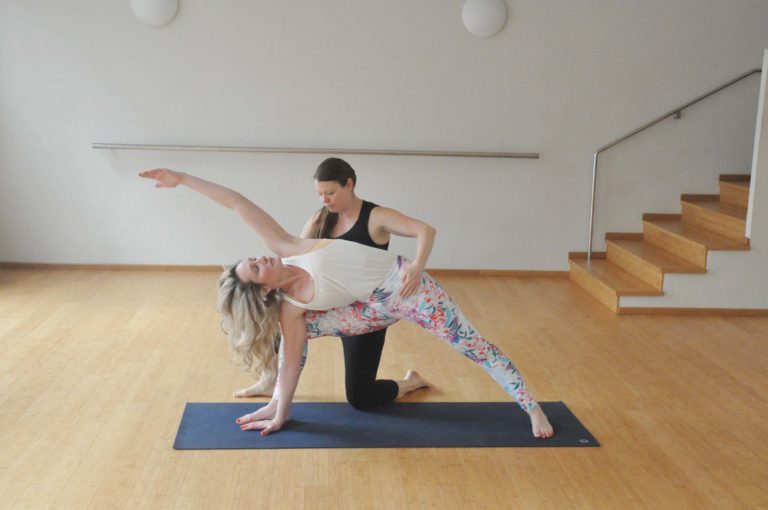Verbal Adjusting in Yoga Practice

When you start teaching yoga verbal adjusting is a safer and easier approach to adjusting. Always start and look at the alignment of a pose from the bottom up in all standing poses. This means everything touching the floor be it hands, feet, forearms, knees etc. if for example you see someone with their hands and feet very far part in Arha Muka Savasana so they look more like someone in plank you would need to explain better the alignment, and you do not need to physically move them. They can do that all on their own.
You might say something like this: “Bring your tailbone towards the ceiling so you are positioned in more like a `V´-shape with your feet hip-width apart and your hands shoulder-width apart.” Or just tell them to bring their feet or hands closer to one another.
If that does not work or you see other misalignments then you might need to explain more. You might see that their fingertips are on the floor and their body is over the shoulders towards the front of the mat, so you would need to say this:
“Bring your upper body back towards your feet, still keep the tailbone up to the ceiling, and feel free to bend your knees to encourage your upper body to come back further. Also, ground all 5 fingers and palm of the hand towards the floor so you are not going to injure your wrists.”
All this can be done verbally. When students do it themselves they get a lot of satisfaction instead of you just physically fixing everything; as they do not know how they got there or even be able to keep themselves in the position you adjusted them too sometimes.
If you have 1 or 2 beginners in your class just try to go to them right at the beginning of class during their first Surya Namaskar so they know right away how to perform Downward Dog, Chaturanga Dandasana and Plank Pose. That way they have it right for the rest of the class and you can leave them doing what they can for the rest of class or going back later as needed.
Often 5 or more students are doing the wrong thing so just telling people to relax their shoulders, activate their abdominal muscles or even lengthen their spine can do wonders for a yoga practice. This will give you more time to teach instead of having to touch someone, which honestly takes time, effort and may even break up the class if you are not able to quickly go back to the group and your vinyasa sequence.
You can verbally adjust an entire group or directly to someone and tell them in a quieter voice what you would like them to do. Heather also finds knowing people’s names and telling them directly what they should be fixing is also a good way of verbally adjusting. Sometimes you just don’t have time to go over to them and physically adjust them or chat with them individually. Knowing their names saves time for the instructor and can keep the flow of a fast vinyasa sequence moving forward. Some students may not want to be pointed out, but if you do it to more than one student in the room, they will accept it as how you teach so they will not get offended.
An example of verbal Adjustments in Phalakasana – Plank Pose:
- Align your shoulders directly over your wrists
- Firm up the front body by activating your abdominal muscles and drawing the ribs in
- Activate the legs strongly
- Spread your fingers, ground through the index and thumb
Verbally adjusting someone you also do not need permission do to so. You are not physically touching them so any injury they cause themselves will be self-afflicting. People don’t normally put themselves into an injury position if you verbally tell them to do so they will only go as far as they can. As a teacher, you will not get blamed for an injury when you do not touch them and also sometimes clients do not like to be touched.

Why wouldn’t a client like to be touched?
- They have an injury
- Just do not like to be touched by strangers or yoga teachers
- Have had an injury from an adjustment given by a yoga teacher in the past
- They think they know more than the teacher
Whatever the reason be compassionate and understanding and refrain from physically adjusting them. Often you notice after physically adjusting someone that they are not interested in your adjustment so I would move on and stop physically adjusting them from then on.
By Heather Anderson
If you want to deepen the practice of adjustments or if you are a certified teacher and must complete your YACEP hours, at Hot Yoga Academy we have the course: The Art of Adjustment.
